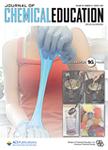版权所有:内蒙古大学图书馆 技术提供:维普资讯• 智图
内蒙古自治区呼和浩特市赛罕区大学西街235号 邮编: 010021

作者机构:Viterbo Univ Dept Biol Biochem & Neurosci La Crosse WI 54601 USA Winona State Univ Dept Chem Winona MN 55987 USA
出 版 物:《JOURNAL OF CHEMICAL EDUCATION》 (化学教育杂志)
年 卷 期:2024年第101卷第7期
页 面:2815-2822页
核心收录:
学科分类:0401[教育学-教育学] 07[理学] 0703[理学-化学]
基 金:UWL's Center for the Advancement of Teaching and Learning (CATL)
主 题:First-Year Undergraduate Second-Year Undergraduate General Chemistry Organic Chemistry Computer-Based Learning Carboxylic Acids Computational Chemistry IR Spectroscopy Molecular Modeling Molecular Properties
摘 要:A straightforward, laptop-friendly computational chemistry laboratory exercise has been developed that facilitates students understanding of the inductive effect. Students implement DFT modeling of acetic acid and its methyl and fluoro analogues: trifluoroacetic, fluoroacetic, propanoic, and 2,2-dimethylpropanoic (pivalic) acids, all at a modest level of theory (revPBE/6-31G*). Individually, students complete all computational aspects in similar to 45 min using a quad-core laptop computer. Students analyze carbonyl (C=O) vibrational frequencies, C=O bond lengths, and Mulliken charges for the acidic hydrogen in each structure. Students use collected data to compare with literature pK(a) values to identify trends of chemical properties (i.e., acidity) and electronic effects (i.e., electron-donating and -withdrawing groups).